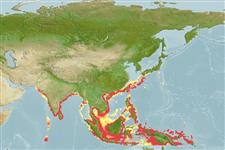Common names from other countries
分类 / Names
俗名 | 同种异名 | Catalog of Fishes(属, 种) | ITIS | CoL | WoRMS | Cloffa
Elasmobranchii
板鳃亚纲 (鲨鱼与 鱼) (sharks and rays) >
Orectolobiformes (Carpet sharks) >
Hemiscylliidae (Bamboo sharks)
Etymology: Chiloscyllium: cheilos (Gr.), lip, referring to membranous and broad lower lip, presumably of C. plagiosum (proposed without a species); skylion, Greek for dogfish or small shark. (See ETYFish); indicum: -icus (Gr.), belonging to: Indian Ocean, type locality. (See ETYFish).
More on author: Gmelin.
Environment: milieu / climate zone / depth range / distribution range
生态学
海洋; 淡水; 半咸淡水 居于水底的; 海洋洄游的 (Ref. 51243); 深度上下限 0 - 90 m (Ref. 106604). 熱帶; 40°N - 10°S, 65°E - 160°E
Indo-West Pacific: India, Sri Lanka, to about Bangladesh; possibly Arabian Sea, and around Thailand and Indonesia (Sumatra). Records from Solomon Islands and north to China and Japan are different species, possibly Chiloscyllium plagiosum.
印度-西太平洋: 阿拉伯海到印度,斯里蘭卡,新加坡,泰國,印尼,越南,台灣,菲律賓與索羅門群島。 可能出現在韓國與日本。
Length at first maturity / 大小 / 重量 / 年龄
Maturity: Lm ?, range 43 - ? cm
Max length : 65.0 cm TL 雄鱼/尚未辨别雌雄; (Ref. 247)
背棘 (总数) : 0; 臀棘: 0. Genus: Nostrils subterminal on snout; pre-oral snout long, mouth closer to eyes than snout tip; eyes and supraorbital ridges hardly elevated; no black hood on head or large spot or spots on sides of body above pectoral fins (Ref. 43278). Caudal fin with a pronounced subterminal notch but without a ventral lobe (Ref. 13575).
Species: Light brown above, cream below, with numerous dark spots on body, tail, and fins, these often forming indistinct vertical bars and saddles (Ref. 31575). Dermal ridge on middle of back and two low lateral ridges (Ref. 4832).
属: 鼻孔靠近吻部末端; 口前的吻长的, 嘴巴较靠近眼睛离吻尖较远; 眼与眶上的脊并不高的; 在头部或胸鳍上面的身体侧边上的大斑点上没有黑色的罩。 (参考文献 43278) 尾鳍有一个明显的接近端位的凹槽但是没有腹的叶.(参考文献 13575)
种: 背面淡褐色的,腹面乳黄色的, 在身体,尾部与鳍上有很多的深色斑点, 这些时常形成不明显的纵带与鞍状斑.(参考文献 31575) 在背面中央与二个低的侧面脊上的表皮的脊.(参考文献 4832)
A common, but little-known inshore sluggish bottom shark (Ref. 13575) found on sandy and muddy bottoms of coastal waters, bays and inlets and rocky and coral reefs. Probably mainly feeds on bottom-dwelling invertebrates (Ref. 13575), also small fishes. Oviparous (Ref. 50449). Utilized for human consumption (Ref. 247). Possibly may occur in fresh water in the lower reaches of the Perak River in peninsular Malaysia (Ref. 43278).
一种常见的, 但是所知极少的近海缓动性的底栖鲨鱼 (参考文献 13575) 发现于沿岸水域的沙泥底,湾内与岩石与珊瑚礁了。 可能主要地吃底栖无脊椎动物 (参考文献 13575) ,也捕食小鱼。 卵生的.(参考文献 50449) 供人类食用.(参考文献 247) 可能地在马来半岛的霹雳河的范围下游出现在淡水。 (参考文献 43278)
Life cycle and mating behavior
Maturities | 繁殖 | Spawnings | Egg(s) | Fecundities | 仔鱼
Oviparous, deposits eggs in small, oval egg cases on the bottom (Ref. 247). Paired eggs are laid. Embryos feed solely on yolk (Ref. 50449). Distinct pairing with embrace (Ref. 205).印度-西太平洋: 阿拉伯海到印度,斯里蘭卡,新加坡,泰國,印尼,越南,台灣,菲律賓與索羅門群島。 可能出現在韓國與日本。
Compagno, L.J.V., 1984. FAO Species Catalogue. Vol. 4. Sharks of the world. An annotated and illustrated catalogue of shark species known to date. Part 1 - Hexanchiformes to Lamniformes. FAO Fish. Synop. 125(4/1):1-249. Rome, FAO. (Ref. 247)
CITES (Ref. 128078)
Not Evaluated
人类利用
渔业: 商业性
工具
特别资料
下载 XML
网络资源
Estimates based on models
Preferred temperature (Ref.
115969): 25.8 - 29.3, mean 28.8 (based on 1477 cells).
Phylogenetic diversity index (Ref.
82804): PD
50 = 0.5039 [Uniqueness, from 0.5 = low to 2.0 = high].
Bayesian length-weight: a=0.00380 (0.00206 - 0.00702), b=3.14 (2.97 - 3.31), in cm Total Length, based on LWR estimates for this species & (Sub)family-body (Ref.
93245).
营养阶层 (Ref.
69278): 4.0 ±0.60 se; based on food items.
回复力 (Ref.
120179): 低的, 最小族群倍增时间4.5 - 14 年 (Fec assumed to be <100).
Fishing Vulnerability (Ref.
59153): Moderate to high vulnerability (46 of 100).
